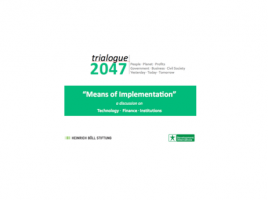Financing Sustainable Development
What Are We Paying For?
2015 promises to be a landmark year in the global dialogue on sustainability, as we anticipate the signing of the Sustainable Development Goals (SDGs). Forming the core of the Post-2015 Development Agenda or the post- MDG (Millennium Development Goals which end in 2015) era, the SDGs are an ambitious set of goals and targets that outline a global framework to end poverty and hunger and promote sustainable development for the next 15 years. These 17 goals and their 169 targets range across issues of health, education, employment, water, energy, cities, oceans, forests etc. Come September and we will see global heads of states assemble in New York to sign the dotted line and set the ball rolling towards ‘the future we want’.
While we rejoice in the participatory nature of arriving at the goals and the wide variety of issues they cover thus building the path for sustainable and inclusive development, there is a very important question we need to ask. What is this going to cost us and who is going to pay for it?
How Much Are We Paying?
Now with goals and targets almost in place, the global negotiations are beginning to address the more mundane operational issues of how they can be achieved. The question of money both how much and who is always a tricky one, whether between friends or when transcending the great global north-south divide. July’s ‘Financing for Development’ conference in Addis Ababa also attempted to tackle this question. An especially sticky spot was separating global SDG pledges from continuing developmental aid and official development assistance (ODA).
The SDGs will have very significant resource implications worldwide. At the global level, total investment needs according to UNCTAD are in the order of USD 5 to USD 7 trillion per year. Developing countries alone are expected to need investments to the tune of about USD 3.9 trillion per year, mainly for basic infrastructure (roads, rail and ports, power stations, water and sanitation), food security (agriculture and rural development), climate change mitigation and adaptation, health and education. Current investment in these sectors is around USD 1.4 trillion leaving a gap of around USD 2.5 trillion and implying an annual investment gap of between USD 1.9 and USD 3.1 trillion (UNCTAD, 2014).
“It’s (Post-2015 Development Agenda) about creating opportunity for all, giving people an equal chance to succeed in life and preparing the world to deal with the challenges of climate change and the next pandemic. We need trillions, not billions of dollars to accomplish these goals and the money will come from many sources: developing countries, private sector investment, donors and international financial institutions. By working together, we can help people build better lives with good education, quality health care, clean water and proper sanitation.”- Jim Yong Kim, President, The World Bank Group
A study of India’s financial requirements and gaps by Development Alternatives indicated that investment requirement for India to meet its SDG goals till 2030 is USD 13.5 trillion, of which USD 1 trillion is apportioned to ensuring sustainable consumption and production patterns. However the current gap in investment already stands at USD 8.5 trillion.
Who Is Going To Be Paying For It?
As the conversation and the consensus moves from billion to trillions of dollars of investment we need to answer the ‘Who’. The predecessors i.e. the MDGs when investments were beyond the ability of the country, they were supported by development aid and debt relief. This lead to a lot of aid flowing into the low income countries especially on issues of health, sanitation, water, hunger and education and raising their development standards. There are only 31 low income countries in the world today.
As the lines between developed and developing economies are blurring, the SDG negotiations also moved away from this status quo as the focus and the financial burden shifts towards developing countries and the private sector. Emerging consensus in civil society is that mobilising domestic resources is a preferred source of financing for development, one that is more stable and fosters democratic ownership and accountability of the development process (Barder, 2015). The Overseas Development Institute analysis however does warn against an overkill. Most low-income countries have little hope of funding even the basic tenets of the SDG agenda such as social protection, universal health coverage and education, even if revenue collection improves. And in these sectors, the private sector is not well-placed to fill the gap (Greenhill, 2015). While not widely acclaimed as a success, some good did come out of last month’s Addis Conference on Financing for Development. The six major multilateral development banks and the International Monetary Fund collectively pledged USD 400 billion in loans and other assistance to help the world’s nations meet their obligations under the new SDGs (Citiscope.org, 2015).
How Can We Pay For It?
Thus, with limited ODA, the onus is on developing countries to look at alternative investment opportunities. Middle-income countries or emerging economies like India occupy a very interesting space in the world today. They have moved from being recipients to becoming providers of capital, technical assistance and foreign aid to the rest of the developing world, while they are simultaneously home to two-thirds of the world’s people living in absolute poverty. South-South technology transfer between developing countries is an interesting approach that can help nations meet their goals.
Goal 12 on Sustainable Consumption and Production targets efficient use of natural resources and implementing the 10 Year Framework Programme (10YFP), one of which is on Sustainable Buildings. Sustainable buildings need sustainable resource efficient building materials.
Development Alternatives with the assistance (technical and financial) of the Swiss Development Cooperation (SDC) adopted an old Chinese technology of brick firing called the Vertical Shaft Brick Kiln (VSBK) to the Indian context in the 1990s. The VSBK is one of the most efficient methods of firing bricks as it reduces fuel consumption and hence carbon emissions by 40%, environmental emissions by 80% and raw material wastage by 30% while providing a quality building material. Post that TARA has been instrumental through a South-South technology and knowledge exchange in transferring this technology to Bangladesh, South Africa, Malawi, Nepal and Vietnam. Thus this approach can help for example Malawi to meet its target for sustainable consumption in the building sector.
There is also an increasing role played by the private sector. Whether prompted by state failure or seeing the large market there is to tap – in Prof. Prahlad’s words – at the bottom of the pyramid, the private sector is increasingly moving into service provision. Social enterprises in the space of health, education, water and energy are mushrooming.
Goal 7 ensures access to affordable, reliable, sustainable and modern energy for all. It targets that by 2030, there will be universal access to affordable, reliable and modern energy services and a substantial increase in the share of renewable energy in the energy mix.
Smart Power India (SPI) has been created with an aim to deliver support services to help scale and replicate sustainable businesses that provide renewable energy to the underserved in rural India. Funded by The Rockefeller Foundation, SPI will work closely with energy service companies (ESCOs) to enable electrification of over 1000 villages. ESCOs will be bringing in private investment to the tune of USD 50 million to build and operate the generation and distribution of renewable energy to households and businesses. Though a small drop in the ocean, such models can be replicated across the country to cater to the 20,000 unelectrified villages in India.
Often the private sector cannot bear the entire burden of investment. This is either due to large amounts of infrastructure required or low perceived demand for essential services such as waste management, conservation, affordable housing etc. thus public-private partnerships are emerging as approaches of choice. The public component comes generally in the form of incentives and ease of access of operation (getting land, assured market), while the private sector manages delivery of the service (capital and operational costs).
Goal 11 is to make cities and human settlements inclusive, safe, resilient and sustainable. It targets by 2030, to reduce the adverse per capita environmental impact of cities, including by paying special attention to air quality and municipal and other waste management.
In collaboration with the Municipal Corporation of Delhi, a pilot project was developed by IL&FS Environmental Infrastructure & Services Ltd (IEISL) in 2010. This public private partnership (PPP) has been initiated for 10 years to demonstrate the potential of a scientifically managed process in relation to the collection and recycling of C&D waste in Delhi. The C&D waste is recycled into aggregates at the waste management facility, which is in turn converted to Ready Mix Concrete (RMC), pavement blocks, kerbstones and concrete bricks. This project demonstrates the viability of PPP models in processing of C&D waste.
Another mode of investment, also alluded to above is domestic resource mobilisation or taxation. OECD countries collect 34% of their GDP as tax. Developing nations collect half this rate (DCR 91) (Fishman, 2015). This of course is not without internal political ramifications and therefore often not a tool of choice. A case in point is the highly acclaimed city of Bogota, Columbia and it’s eccentric mayor Anatanas Mockus. When the City Council turned down his request to raise taxes to deal with the city’s expenses, he asked people to pay 10% extra in voluntary taxes. About 63,000 people voluntarily paid the taxes.
Another interesting initiative that arose from July’s Financing Conference was the Global Partnership for Sustainable Development Data, launched with modest seed financing but could signal a new approach to building new public accountability systems that track resources to results. Such mechanisms will help build confidence of various stakeholders who invest in the SDGs in terms of finances, people, capacities, technology, knowledge and hope. q
Kriti Nagrath
knagrath@devalt.org
This blog was first published in the special edition of Development Alternatives’ Newsletter for the month of August 2015, under ‘Policy Focus’
References:
• Barder, O. (2015, July). Retrieved from Addis: A Good First Step, but a Terrible Last Word, for 2015.
• Citiscope.org. (2015, July). Retrieved from http://citiscope.org/habitatIII/news/2015/07/multilaterals-financial-pledge-sdgs-earmarks-nothing-cities#sthash.nsB01g4s.dpu
• Fishman. (2015, February). Facts and Figures on Financing for Sustainable Development: A brief compilation. Retrieved June 2015, from http://www.irf2015.org/sites/default/files/publications/Retreat%20%236_SD% 202_Final%20for%20website.pdf
• Greenhill, R. (2015, July). Retrieved from From Addis to New York: What does the FFD summit imply for the SDGs?
• Mcarthur, J. (2015, July). The Brooklings Institute. Retrieved from Concepts and Constraints: http://www.brookings.edu/blogs/up-front/posts/2015/07/20-addis-financing-development-conference-mcarthur
• UNCTAD. (2014). Investing in SDGs: An Action Plan for promoting private sector contributions, Chapter 4. Retrieved June 2015, from http://unctad.org/en/PublicationChapters/wir2014ch4_en.pdf
The views expressed in the article are those of the author’s and not necessarily those of Development Alternatives.






Leave a Reply